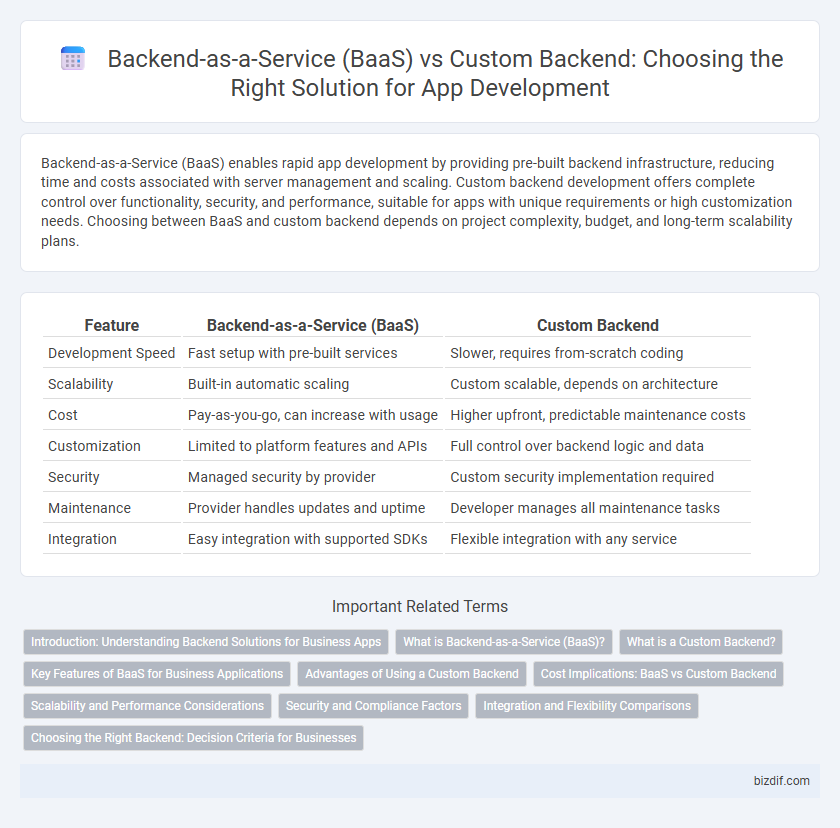Backend-as-a-Service (BaaS) enables rapid app development by providing pre-built backend infrastructure, reducing time and costs associated with server management and scaling. Custom backend development offers complete control over functionality, security, and performance, suitable for apps with unique requirements or high customization needs. Choosing between BaaS and custom backend depends on project complexity, budget, and long-term scalability plans.
Table of Comparison
| Feature | Backend-as-a-Service (BaaS) | Custom Backend |
|---|---|---|
| Development Speed | Fast setup with pre-built services | Slower, requires from-scratch coding |
| Scalability | Built-in automatic scaling | Custom scalable, depends on architecture |
| Cost | Pay-as-you-go, can increase with usage | Higher upfront, predictable maintenance costs |
| Customization | Limited to platform features and APIs | Full control over backend logic and data |
| Security | Managed security by provider | Custom security implementation required |
| Maintenance | Provider handles updates and uptime | Developer manages all maintenance tasks |
| Integration | Easy integration with supported SDKs | Flexible integration with any service |
Introduction: Understanding Backend Solutions for Business Apps
Backend-as-a-Service (BaaS) offers pre-built cloud infrastructure and APIs that accelerate app development by handling server management, databases, and authentication. Custom backend development provides tailored solutions optimized for specific business needs, allowing greater control over functionality and scalability. Choosing between BaaS and custom backends depends on factors such as development speed, budget, and long-term maintenance requirements.
What is Backend-as-a-Service (BaaS)?
Backend-as-a-Service (BaaS) is a cloud-based platform that provides ready-to-use backend infrastructure, including databases, authentication, APIs, and server management, streamlining app development. BaaS enables developers to focus on frontend features by handling complex server-side functions and scaling automatically. Popular BaaS providers like Firebase, AWS Amplify, and Backendless offer integration with multiple frameworks, reducing development time and operational overhead.
What is a Custom Backend?
A custom backend is a tailored server-side solution designed specifically to meet the unique requirements of an application, allowing full control over data management, security protocols, and business logic. Unlike Backend-as-a-Service (BaaS), it requires in-house development and maintenance but offers greater flexibility and scalability for complex and specialized app functionalities. Custom backends typically leverage frameworks and languages such as Node.js, Django, or Ruby on Rails to build robust APIs and integrate seamlessly with front-end architectures.
Key Features of BaaS for Business Applications
Backend-as-a-Service (BaaS) offers essential features such as real-time database management, user authentication, cloud storage, and serverless functions, enabling rapid app development without extensive backend coding. Pre-built APIs and scalable cloud infrastructure reduce time-to-market and operational complexity for business applications. Integration with analytics and push notification services further enhances user engagement and data-driven decision-making.
Advantages of Using a Custom Backend
A custom backend offers unparalleled flexibility and control, enabling developers to tailor functionalities precisely to project requirements and optimize performance. It ensures greater data security by allowing the implementation of bespoke authentication and encryption protocols, minimizing vulnerabilities inherent in generic Backend-as-a-Service (BaaS) platforms. Custom backend solutions facilitate seamless integration with various third-party services and legacy systems, providing scalability and adaptability essential for complex or large-scale applications.
Cost Implications: BaaS vs Custom Backend
Backend-as-a-Service (BaaS) offers lower upfront costs and faster deployment by providing pre-built infrastructure and scalability, ideal for startups and small projects. Custom backend development incurs higher initial expenses due to bespoke architecture design and coding but allows greater control, flexibility, and long-term cost optimization for complex, large-scale applications. Evaluating cost implications requires balancing immediate budget constraints against future scalability, maintenance, and customization needs.
Scalability and Performance Considerations
Backend-as-a-Service (BaaS) platforms offer scalable infrastructure with built-in load balancing and auto-scaling features, enabling rapid deployment without extensive backend management. Custom backend solutions provide tailored scalability and optimized performance, allowing developers to fine-tune resource allocation and implement specialized caching or database strategies. Evaluating app requirements and anticipated user growth is crucial for choosing between the flexible, managed environment of BaaS and the fully controlled, customizable nature of a custom backend.
Security and Compliance Factors
Backend-as-a-Service (BaaS) platforms offer built-in security features and compliance certifications such as GDPR, HIPAA, and SOC 2, reducing the burden on developers to implement and maintain security protocols. Custom backend solutions provide greater control over data handling and security configurations, allowing tailored compliance measures and the ability to address unique organizational policies. Evaluating security risks, data sensitivity, and compliance requirements is essential when choosing between BaaS and custom backend architectures in app development.
Integration and Flexibility Comparisons
Backend-as-a-Service (BaaS) offers seamless integration with pre-built APIs and SDKs, enabling rapid app development while limiting customization options. Custom backend solutions provide maximum flexibility in designing tailored APIs, data structures, and workflows but require more development time and expertise. Choosing between BaaS and custom backend depends on the balance between speed of integration and the need for scalable, highly customized backend architectures.
Choosing the Right Backend: Decision Criteria for Businesses
Selecting between Backend-as-a-Service (BaaS) and a custom backend hinges on factors such as development speed, scalability, and long-term cost. BaaS platforms offer rapid deployment and reduced maintenance overhead, making them ideal for startups and MVPs, whereas custom backends provide tailored solutions with greater control over performance and security, suited for complex or highly specialized applications. Businesses should evaluate their technical expertise, anticipated traffic, data sensitivity, and budget constraints to make an informed decision that aligns with their growth strategy.
Backend-as-a-Service (BaaS) vs Custom backend Infographic

 bizdif.com
bizdif.com